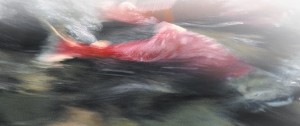
Filtration through column of soil and sand eliminates toxic effects of urban stormwater on fish.
October 20, 2015
Toxic runoff from highways, parking lots and other developed surfaces is killing many of the adult coho salmon in urban streams along the West Coast, according to a new study that for the first time documents the fatal connection between urban stormwater and salmon survival.
That’s the bad news. The good news is that the same study published a paper in the Journal of Applied Ecology in which the authors found that inexpensive filtration of urban runoff through simple columns of sand and soil can completely prevent the toxic effects on fish.
The research was funded by Washington Sea Grant, NOAA Coastal Storms Program, Region 10 of the U.S. Environmental Protection Agency, Puget Sound Partnership, and Puget Sound Regional Stormwater Monitoring Program.
“Untreated urban runoff is very bad for salmon health,” said Julann Spromberg, a research scientist at NOAA Fisheries’ Northwest Fisheries Science Center (NWFSC) in Seattle. “Our goal with this research is to find practical and inexpensive ways to improve water quality. The salmon are telling us if they work.”
WSG-funded scientist and coauthor of the study Jen McIntyre, aquatic ecotoxicologist with Washington State University, and others have studied the impacts of urban stormwater on salmon extensively around Puget Sound, where more than half of the coho returning to stormwater-dominated streams every year die before they can spawn.
The filtration columns, similar to “rain gardens,” are an example of emerging green stormwater infrastructure that should be integrated into future development and redevelopment to reverse the trend and help coho recover, the authors conclude.
“If we can incorporate clean water design strategies into future growth, as some transportation projects are already doing, wild salmon might have a chance,” said Nat Scholz, manager of the Ecotoxicology Program at NWSFC in Seattle and a coauthor of the study. “They can’t take the kinds of losses we’ve documented in urban streams.”
The study exposed adult coho salmon from the Suquamish tribal hatchery in Poulsbo, Washington, to different degrees of polluted and clean water, including runoff from a busy urban highway in Seattle. All fish exposed to the highway runoff died within 24 hours.
But after researchers filtered the water through a roughly three-foot-high soil column containing layers of gravel, sand, compost and bark, all the exposed coho survived as well as they did in clean water. Tests showed the filtration columns reduced toxic heavy metals by 58 percent and polyaromatic hydrocarbons, which are byproducts of gasoline combustion, by 94 percent.
“What impressed me most was the effectiveness of the treatment,” said McIntyre. “It’s remarkable that we could take runoff that killed all of the adult coho in less than 24 hours — sometimes less than four hours — and render it non-toxic, even after putting several storms worth of water through the same soil mixture.”
“The recurring coho spawner deaths have been a high profile mystery for many years, and we’re now much closer to the cause,” Scholz said. “Although we haven’t identified a smoking gun, our study shows that toxic stormwater is killing coho, and that the problem can be addressed.”
OCT
2015